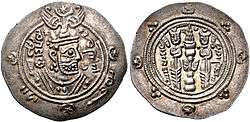Gil Gavbara
| Gil Gavbara | |
|---|---|
| Ispahbadh of Tabaristan | |
 Coin of Gil Gavbara | |
| Reign | 642-660 |
| Successor | Dabuya |
| Born |
7th-century Gilan |
| Died |
660 Tabaristan |
| House | Dabuyid dynasty |
| Father | Piruz |
| Mother | Gilani princess |
| Religion | Zoroastrianism |
Gil Gavbara (Persian: گیل گیلانشاه), known in Arabic sources as Jil-i Jilanshah and Gavbarih, was king and founder of the Dabuyid dynasty in 642, ruling until his death in 660.
Origins
According to Ibn Isfandiyar, the Dabuyids were descended from Djamasp, a brother of the Sassanid shah Kavadh I. Gil Gavbara was the son of Piruz, who is described as brave as the Iranian mythological hero Rostam. Piruz later became the ruler of Gilan, and married a woman who bore him a son named Gil Gavbara.[1]
Biography
Piruz died around 642 and was succeeded by Gil Gavbara as the ruler of Gilan. Gil Gavbara was later given all of Tabaristan, which led to the formal conferment of the titles of Gil-Gilan ("ruler of Gilan") and Padashwargarshah ("Shah of Patashwargar", the old name of Tabaristan's mountains) to Gil Gavbara's son Dabuya by the last Sasanian shah, Yazdegerd III.
References
- ↑ Madelung 1993, pp. 541–544.
Sources
- Madelung, W. (1975). "The Minor Dynasties of Northern Iran". In Frye, R.N. The Cambridge History of Iran, Volume 4: From the Arab Invasion to the Saljuqs. Cambridge: Cambridge University Press. pp. 198–249. ISBN 978-0-521-20093-6.
- Madelung, Wilferd (1993). "DABUYIDS". In Yarshater, Ehsan. Encyclopaedia Iranica, Vol. VI, Fasc. 5. London et al.: Routledge & Kegan Paul. pp. 541–544. ISBN 1-56859-007-5.
- Pourshariati, Parvaneh (2008). Decline and Fall of the Sasanian Empire: The Sasanian-Parthian Confederacy and the Arab Conquest of Iran. London and New York: I.B. Tauris. ISBN 978-1-84511-645-3.
- Ibn, Isfandiyar (1905). An Abridged Translation of the History of Tabaristan. University of Michigan: BRILL. pp. 1–356. ISBN 9789004093676.
Gil Gavbara Born: Unknown Died: 660 | ||
| Iranian royalty | ||
|---|---|---|
| Preceded by Piruz |
Ispahbadh of Tabaristan 642-660 |
Succeeded by Dabuya |
